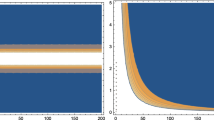Abstract
We use one of the simplest forms of the K-essence theory and apply it to the anisotropic Bianchi type IX cosmological model, with a barotropic perfect fluid modeling the usual matter content. We show that the most important contribution of the scalar field occurs during a stiff matter phase. Also, we present a canonical quantization procedure of the theory which can be simplified by reinterpreting the scalar field as an exotic part of the total matter content. The solutions to the Wheeler-DeWitt equation were found using the Bohmian formulation Bohm (Phys. Rev. 85(2):166, 1952) of quantum mechanics, employing the amplitude-real-phase approach Moncrief and Ryan (Phys. Rev. D 44:2375, 1991), where the ansatz for the wave function is of the form Ψ(ℓ μ)=χ(ϕ)W(ℓ μ)\(e^{- S(\ell ^{\mu })},\), where S is the superpotential function, which plays an important role in solving the Hamilton-Jacobi equation.
Similar content being viewed by others
References
Bohm, D: Phys. Rev. 85(2), 166 (1952)
Moncrief, V., Ryan, M.P.: Phys. Rev. D 44, 2375 (1991)
Armendariz-Picon, C., Mukhanov, V., Steinbardt, P.J.: Phys. Lett. 85, 4438 (2000)
Armendariz-Picon, C., Mukhanov, V., Steinbardt, P.J.: Phys. Rev. D 63, 103510 (2001)
Bose, N., Majumdar, A.S.: Phys. Rev. D 79, 103517 (2009). A K-essence model of inflation, dark matter and dark energy. arXiv:0812.4131
De-Santiago, J., Cervantes-Cota, J. L.: Phys. Rev. D 83, 063502 (2011)
Saez, D., Ballester, V.J.: Phys. Lett. A 113, 467 (1986)
de Putter, R., Linder, E. V.: Astropart. Phys. 28, 263 (2007). Kinetic K-essence and quintessence. arXiv:0705.0400
Chiba, T., Dutta, S., Scherrer, R.J.: Phys. Rev. D 80, 043517 (2009). Slow-roll K-essence. arXiv:0906.0628
Arroja, F., Sasaki, M.: Phys. Rev. D 81, 107301 (2010). A note on the equivalence of a barotropic perfect fluid with a K-essence scalar field. arXiv:10021376
García, L.A., Tejeiro, J.M., Castañeda, L.: K-essence scalar field as dynamical dark energy. arXiv:1210.5259
Bilic, N., Tupper, G., Viollier, R.: Phys. Lett. B 535, 17 (2002)
Bento, M., Bertolami, O., Sen, A.: Phys. Rev. D 66, 043507 (2002). Dynamics of dark energy. arXiv:hep-th.0603057
Armendariz-Picon, C., Damour, T., Mukhanov, V.: Phys. Lett. B 458, 209 (1999)
Garriga, J., Mukhanov, V.: Phys. Lett. B 458, 219 (1999)
Copeland, E.J., Sami, M., Tsujikawa, S.: Int. J. Mod. Phys. D 15, 1753–1936 (2006). Dynamics of dark energy. arXiv:hep-th.0603057
Ryan, M.P.: Hamiltonian cosmology. Springer, Berlin (1972)
Kodama, H.: Progress of Theor. Phys. 80, 1024 (1988)
Kodama, H.: Phys. Rev D 42, 2548 (1990)
Chimento, L. P.: Phys. Rev. D 69, 123517 (2004)
Scherrer, R. J.: Phys. Rev. Lett. 93, 011301 (2004)
Arroja, F., Sasaki, M.: Phys. Rev. D 81, 107301 (2010)
De-Santiago, J., Cervantes-Cota, J.L.: Phys. Rev. D 83, 063502 (2011)
Madsen, M.: Class. Quantum Grav. 5, 627 (1988)
Pimentel, L.O.: Class. Quantum Grav. 6, L263 (1989)
Hartle, J., Hawking, S.W.: Phys. Rev. D 28, 2960 (1983)
Polyanin, A. C., Zaitsev, V. F.: Handbook of Exact solutions for ordinary differential equations, 2nd edn. Chapman & Hall/CRC (2003)
Guzmán, W., Sabido, M., Socorro, J., Ureña-López, L. A.: Int. J. Mod. Phys. D 16(4), 641–653 (2007). arXiv:gr-qc/0506041
Moniz, P.: Quantum Cosmology: The Supersymmetric Perspective, Vol 1 and 2, Lecture Notes in Physics 803 and 804. Springer (2010)
Obregón, O., Socorro, J.: Int. J. Theor. Phys. 35, 1381 (1996). Ψ = W e ±Φ quantum cosmological solutions for class A Bianchi models. arXiv:gr-qc/9506021
Hawking, S.W.: Nucl. Phys. B239, 257 (1984)
Asano, M., Tanimoto, M., Yoshino, N.: Phys. Lett. B 314, 303 (1993)
Lidsey, J.E.: Phys. Rev. D 49, R599 (1994)
Acknowledgments
This work was partially supported by CONACYT 167335, 179881 grants. PROMEP grants UGTO-CA-3 and UAM-I-43. A.E.G. is supported by a CONACYT graduate fellowship. This work is part of the collaboration within the Instituto Avanzado de Cosmología and Red PROMEP: Gravitation and Mathematical Physics under project Quantum aspects of gravity in cosmological models, phenomenology and geometry of space-time. Many calculations where done by Symbolic Program REDUCE 3.8.
Author information
Authors and Affiliations
Corresponding author
Appendix: Energy Momentum Tensor
Appendix: Energy Momentum Tensor
The energy momentum tensor of the K-essence scalar field has the form (5)
the covariant derivative of which is
where the term inside the curly brackets is null according to the field equation for the scalar field.
Now, making the identifications
it is easy to show that
which establishes an analogy with the energy momentum tensor of a perfect fluid (see (6)).
In the case of the SB scalar field (\(\mathrm \mathcal {G}(X)=X\)) it can be seen from the general identification (51) that P(X) = ρ(X), which means that the energy momentum tensor (6) for this restricted model has the structure of a stiff fluid.
Rights and permissions
About this article
Cite this article
Espinoza-García, A., Socorro, J. & Pimentel, L.O. Quantum Bianchi Type IX Cosmology in K-Essence Theory. Int J Theor Phys 53, 3066–3077 (2014). https://doi.org/10.1007/s10773-014-2102-0
Received:
Accepted:
Published:
Issue Date:
DOI: https://doi.org/10.1007/s10773-014-2102-0




